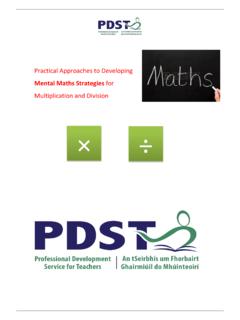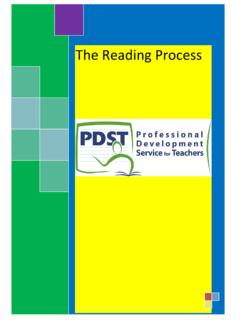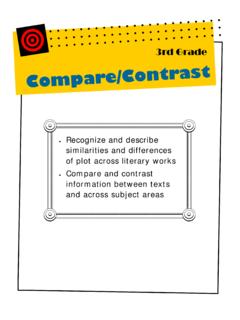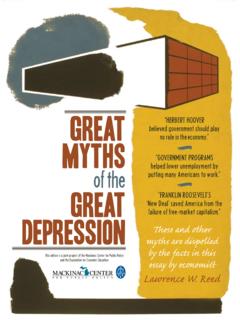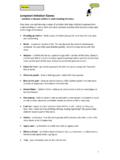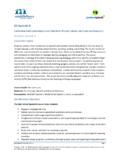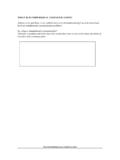Transcription of Writing Genre – A Structured Approach
1 1 Writing Genre A Structured Approach 2013 2 Introduction The Primary School Curriculum recognises the act of Writing as part of the language learning process. Writing is a skill and a craft that needs to be taught and which is learned from practice. The diagram below illustrates the key components of Writing . Components of Writing This manual provides guidance on how schools may Approach the teaching of a number of Writing genres. While the focus is on seven genres, this list is not exhaustive. Appropriate assessment tools are suggested, along with a variety of practical activities. Students should be given opportunities to engage actively and collaboratively in analysing, interpreting and constructing a variety of genres. Such skills and processes need to be modelled, shared and guided before they are practised independently in a manner that is integrated across literacy and across the curriculum. In maths class for example, students will be encouraged to use the language of maths and the structure of procedural Writing to explain how they have solved a problem.
2 In this way, Writing becomes a pathway to learning. Free Writing 3 Writing Genres Definitions and activities to support classroom implementation. Please note that these activities are adapted from First Steps Writing 2nd Edition, 2005. Narrative Writing Narratives entertain and engage the reader in an imaginative experience. Narrative texts are organised according to setting, event leading to a problem and solution. The main features of narrative Writing are: defined characters, descriptive language, past tense. 1. Tired Words/Boring Sentences Children chose overused words from their own and other people s Writing and they brainstorm alternatives Read sentence carefully Brainstorm alternative words for each word in the sentence / list Create a new sentence using some words from the alternative list. Compare original sentence and new sentence 2. Connecting Words Scan the first few pages of texts to find connecting words- for example, and, but, when Write each word on a card and display Use sentences to give children opportunity to see the words in use, for example, Complete the I went to the and/but/because 3.
3 Pass-it-on Sitting in small groups, children each write first sentence of story- set the scene and name two characters (one male & one female) Children then fold back the section on which they have written so that it cannot be seen and pass the paper to the next person who writes a sentence beginning with Suddenly Repeat the procedure- folding, passing and adding sentences. She After In the Group then unfolds paper and read narrative to group! 4. Building Character Profiles Children receive a picture of a character and build a simple profile based on a number of characteristics (I look like, I wear etc.) 4 More complicated characteristics for more senior children (Aspirations etc.) Can develop it to focus just on one feature ( Eyes, colour, shape, look) Samples of Narrative Writing *Narrative sample for Junior classes Little Red Riding Hood Once upon a time there was a little girl who lived at the edge of a large dark forest.
4 She always wore a red coat so everyone called her Little Red Riding Hood. One day, her mother gave her a basket of food and told her to take it to her grandmother. On the way, Little Red Riding Hood met a wolf. Where are you going? he asked. I m going to my grandmother s house , Red Riding Hood said. The greedy wolf took a short cut to the grandmother s house and put on her clothes. When Red Riding Hood got there, she did not know her grandmother. What big teeth you have she said. All the better to eat you said the wolf. Red Riding Hood shouted Help someone Help! A woodcutter came and chased the wolf away. Little Red Riding Hood s granny got out of the press where she was hiding and they had a lovely tea. *Narrative sample for Senior Classes Na Tr Mhuic n L amh in th g na tr mhuic n a dtithe. Rinne muic n amh in teach as tu . Rinne muic n eile teach as adhmad agus rinne an tri mhuic n a theach as br c . Chnag an mac t re ar doras an t a bh d anta as tu.
5 Lig isteach m . Lig isteach m ! arsa an mac t re. N ligfidh m isteach th arsa an ch ad mhuic n. T igh abhaile! Bhuel, s idfidh m is leagfaidh m do theach tu ! Ansin sh id s agus sh id s agus leag s an teach tu ! Chnag an mac t re ar dhoras an t adhmaid. Lig isteach m . Lig isteach m ! arsa an mac t re. N ligfidh m isteach th arsa an dara muic n . T igh abhaile! Bhuel, s idfidh m is leagfaidh m do theach adhmaid! Ansin sh id s agus sh id s agus leag s an teach adhmaid! Chnag an mac t re ar dhoras an t a bh d anta as br c . Lig isteach m . Lig isteach m ! arsa an mac t re. N ligfidh m isteach th arsa an tr mhuic n. T igh abhaile! Bhuel, s idfidh m is leagfaidh m do theach br c ! Ansin sh id s agus sh id s ach n orbh fh idir leis an teach leis na bhric a leagadh! Ansin chuaigh an mac t re suas ar an d on s os an siml ar leis PLOP! Isteach san uisce leis an mac t re. Thosaigh na tr mhuic n ag g ire!
6 5 Connectives/ Conjunctions/ Joining Words And or but yet Even though while Although like as after Before since when for If unless in case also Whereas despite Because now that provided that Such as for example however Furthermore similarly On the other hand 6 I can think about a character and write a sentence. Appearance: _____ Can you use adjectives? _____ 7 I look like I wear I like to .. I Don t tell anyone but my name is_____ 8 Recount Writing Recount tells the reader what happened and this may involve the author s personal interpretation of events. There are different types of recounts which including personal (my trip to the farm), factual (retelling an accident) and imaginative recounts (a day in the life of a puppy). Recount Writing is organised by setting, events in chronological order and a concluding statement.
7 The main features of recount Writing are specific participants, action verbs and past tense. 1. Tell your news In pairs, small groups and whole class use the clown poster to guide you 2. Create shared experiences that can then be re-told or written by children In pairs, small groups or recorded on tape ( blowing bubbles, PE, a school trip). Teacher can scribe for children during shared Writing and then use the subsequent text for reading activities 3. Class diary Teacher may act as a scribe and record some class news in the form of a recount each day for a week. Display each days recount on a wall then collate and put into the class library. Re read entries every day that week. Older children may wish to keep their own weekly diary 4. Set up a daily news broadcast Where children use props ( microphone and hat) and prepare and deliver a short news story to the class 5. Living charts Jointly create and display charts of terms used by the children in their oral and written recounts under the following headings: who, where, when, feelings ( WHO: cousin, sister, best friend, WHERE: park, school, cinema, WHEN: yesterday, weekend, after school, FEELINGS: bored, ecstatic, surprised, delighted etc.)
8 Add to these charts whenever a new term arises and add terms that are commonly used in the children s free Writing . Model using words from these charts when modelling Writing to the children 6. Use simple templates to organise recounts 7. Class Writing Bag Send home the Writing bag and encourage students to recount personal experiences 8. Sequence Events Have students recall an experience shared by the class, in small groups write each event on a sentence strip, then have another group sequence the strips 9. Use to create a pictorial or written timeline of an experience. *Recount Sample for Junior Classes 9 At the Beach My friend and I went to the beach on Saturday. While we were at the beach we had a cool swim. After our swim we built sandcastles. Later it began to rain, so we packed up and went home. We were tired from our day at the beach, so we went to bed early *Recount Sample for Middle Classes A Trip to the Zoo Yesterday my family went to the zoo to see the elephant.
9 When we got to the zoo, we went to the shop to buy some food to give to the animals. After getting the food we went to the nocturnal house where we saw birds and reptiles which only come out at night. Before lunch we went for a ride on the elephant. It was a thrill to ride it. Dad nearly fell off when he let go of the rope. During lunch we fed some birds in the park. In the afternoon we saw the animals being fed. When we returned home we were tired but happy because we had so much fun. 10 *Recount Sample for Senior Classes Sunday, 14 June, 1942 On Friday, June 12th, I woke up at six o clock and no wonder, it was my birthday. But of course I was not allowed to get up at that hour, so I had to control my curiosity until a quarter to seven. Then I could bear it no longer, and went to the dining room, where I received a warm welcome from Moortje (the cat). Soon after seven I went to Mummy and Daddy and then to the sitting room to undo my presents.
10 The first to greet me was you, possibly the nicest of all. Then on the table there were a bunch of roses, a plant, and some peonies, and more arrived during the day. I got masses of things from Mummy and Daddy, and was thoroughly spoiled by various friends. Among other things I was given Camera Obscura, a party game, lots of sweets, chocolates, a puzzle, a brooch, Tales and Legends of the Netherlands by Joseph Cohen, Daisy s Mountain Holiday (a terrific book) and some money. Now I can by The Myths of Greece and Rome grand! Then Lies called for me and we went to school. During recess I treated everyone to sweet biscuits, and then we had to go back to our lessons. Now I must stop. Bye-bye, we re going to be great pals! Source: The Diary of a Young Girl , Anne Frank, Bantam Publishers 11 Procedural Writing Procedures are written to explain how something is done, in a series of sequenced steps.



